This Week in Infrastructure: The Cascading Effect of Aging Infrastructure
December 19th, 2014 | By: Olivia Wolfertz
As the weather changes and our infrastructure continues to be neglected, issues and disruptions are increasing. Infrastructure collapses, like the water main break in DC, remind us that failing infrastructure is fragile and unpredictable—and should be continuously maintained to help prevent a crisis. On Tuesday in Washington, D.C., a 12-inch water main ruptured below ground, flooding three subway lines and damaging the streets above it. According to DC Water, the pipe was 61 years old, a relatively young pipe among a system with a median age of 79 years. Some pipes in the system even date back to the Civil War era. DC’s drinking water infrastructure requires $1.6 billion in upgrades over the next 20 years and the sewer system needs $2.5 billion in fixes. There are 240,000 water main breaks per year and one every two minutes in the United States because of aging pipes. The DC water main break, which affected both the metro rails and streets above, shows the domino effect of one piece of infrastructure’s impact on others. DC is not the only place where aging infrastructure has shouted for investments. This week, the Nevada Section of ASCE released its state Report Card, where the overall grade was a C-. The report points to the state’s great transportation and infrastructure needs to be discussed in next year’s legislation session. In an op-ed piece from Vermont, the author called for stronger dam legislation, citing the Report Card for Vermont’s Infrastructure’s data. Due to increasing visible need for infrastructure repair, more and more states are taking action to fund infrastructure projects through various measures. In Washington, Gov. Jay Inslee unveiled a 12-year, $12 billion transportation proposal, which would be paid for with fees and a new carbon pollution charge. States like Michigan, Tennessee and North Carolina are also pushing for transportation funding at the state level. Though action on the state level to increase infrastructure funds is encouraging, the best thing for our nation and our economy is to fix the Highway Trust Fund and increase the national gas tax to match inflation.Tags: dams, highway trust fund, infrastructure, infrastructure report card, state report cards, water, water infrastructure
No Comments »
Celebrating Infrastructure Successes in 2013
December 27th, 2013 | By: Infrastructure Report Card
Looking back over 2013, we have many successes in making infrastructure a priority to celebrate. Here are a few that really made our year: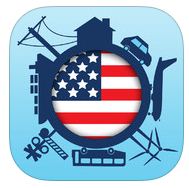 1. The 2013 Report Card for America’s Infrastructure was launched in March as a tablet and smartphone app gaining more traction with the media and decision makers than ever before and was even mentioned by President Obama during a “Rebuilding America” event at the Port of Miami.
2. Stephen Colbert showcased the uptick in America’s Report Card grades as a “Tiny Triumph” on the Colbert Report in April taking the infrastructure message to a whole new audience.
3. The Water Resources Development Act which will greatly help our ports and inland waterways deal with their pressing needs is currently in the hands of a House and Senate conference committee, and we hope to see it enacted early in 2014 (stay tuned!). It’s not too late to tell your member of Congress that this should be on Congress’ 2014 to-do list. Email them right here with a few clicks.
4. Major infrastructure funding legislative initiatives took off in several states including Maryland, Massachusetts, Pennsylvania, Virginia, Vermont, Wyoming, Texas, and Maine.
5. Several new bills were introduced that would start improving the nation’s infrastructure: The Partnership to Build America Act (H.R. 2084), which could re-shape the way infrastructure in the United States is financed; the UPDATE Act (H.R. 3636), which would increase investment in transportation infrastructure through an increase in the federal gas tax/user fee; the BRIDGE Act (S. 1716)/National Infrastructure Development Bank Act (H.R. 2553), both of which would facilitate infrastructure investment through creation of a national infrastructure bank.
1. The 2013 Report Card for America’s Infrastructure was launched in March as a tablet and smartphone app gaining more traction with the media and decision makers than ever before and was even mentioned by President Obama during a “Rebuilding America” event at the Port of Miami.
2. Stephen Colbert showcased the uptick in America’s Report Card grades as a “Tiny Triumph” on the Colbert Report in April taking the infrastructure message to a whole new audience.
3. The Water Resources Development Act which will greatly help our ports and inland waterways deal with their pressing needs is currently in the hands of a House and Senate conference committee, and we hope to see it enacted early in 2014 (stay tuned!). It’s not too late to tell your member of Congress that this should be on Congress’ 2014 to-do list. Email them right here with a few clicks.
4. Major infrastructure funding legislative initiatives took off in several states including Maryland, Massachusetts, Pennsylvania, Virginia, Vermont, Wyoming, Texas, and Maine.
5. Several new bills were introduced that would start improving the nation’s infrastructure: The Partnership to Build America Act (H.R. 2084), which could re-shape the way infrastructure in the United States is financed; the UPDATE Act (H.R. 3636), which would increase investment in transportation infrastructure through an increase in the federal gas tax/user fee; the BRIDGE Act (S. 1716)/National Infrastructure Development Bank Act (H.R. 2553), both of which would facilitate infrastructure investment through creation of a national infrastructure bank.
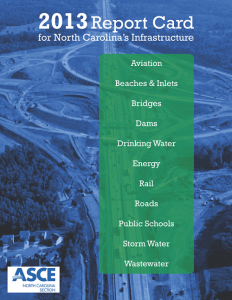 6. Five states – North Carolina, Oklahoma, Kansas, Missouri, and Washington – put out state-based Infrastructure Report Cards challenging their state’s leaders to get to work on the infrastructure issues in their area.
Thanks for your support in making these happen and we look forward to making 2014 an even bigger year for infrastructure!
6. Five states – North Carolina, Oklahoma, Kansas, Missouri, and Washington – put out state-based Infrastructure Report Cards challenging their state’s leaders to get to work on the infrastructure issues in their area.
Thanks for your support in making these happen and we look forward to making 2014 an even bigger year for infrastructure!
Tags: app, media, report card, state, state report cards, transportation, water
No Comments »
Mr. Civil Engineer Goes to Washington
July 17th, 2013 | By: America's Infrastructure Report Card
Happy 4th of July, America! Baseball’s All-Star break is this week. These and more serve as reminders that we have reached the “mid-point” of the summer. Are your summer advocacy plans in place? If you are an ASCE member, you should start your advocacy plan by signing up for the next Key Contact Briefing Conference Call on July 23 with Rep. David McKinley, P.E., F.ASCE. An ASCE member since his days as a student at Purdue University, Rep. McKinley represents the 1st District of West Virginia and will join us on July 23 to share his experience as a civil engineer in Congress, and why it’s important for ASCE members to meet often with their elected officials to share the civil engineer’s take on issues. As Congress continues to wrestle with many challenges, ASCE members and infrastructure supporters of all backgrounds should make sure their elected leaders are informed about the conditions of our nation’s infrastructure, and the consequences we face if we continue to neglect its needs. ASCE’s 2013 Report Card for America’s Infrastructure lays out these points on 16 different categories of infrastructure. In addition, ASCE Sections and Branches have released over 30 state and local Report Cards to provide a more localized picture of infrastructure conditions. This information is valuable when in the hands of decision-makers in Congress as they discuss issues such as the Water Resources Development Act, and the importance of preserving tax exemptions for municipal bonds to improve infrastructure in local communities. Learn how you can help your elected leaders make informed decisions about our infrastructure using ASCE’s Key Contact tools by joining Rep. McKinley and ASCE staff on July 23. Join us on July 23 at 1pm EDT/12noon CDT for “Bringing the Report Card to Elected Leaders”, the next Key Contact Briefing Conference Call, open to all ASCE members (a member login is required to register for the call.)Get to Know North Carolina’s Mediocre Infrastructure
June 5th, 2013 | By: America's Infrastructure Report Card
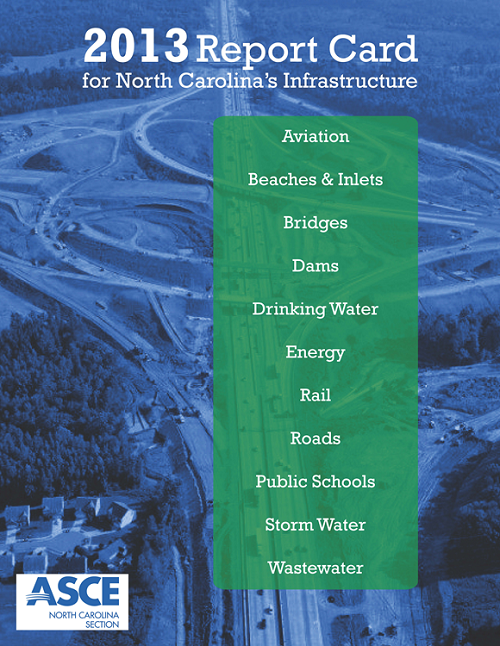 Today, North Carolina’s civil engineers released a new Infrastructure Report Card. After spending a year diving into the details of the state’s infrastructure – from bridges to beaches to dams – they determined that North Carolina’s infrastructure only deserved a mediocre C grade. Like many areas of the country, North Carolina has some work to do to make sure maintenance gets done, aging parts of the system get a modern overhaul, and the infrastructure keeps up with the state’s growth.
The state-wide report examined eleven categories of infrastructure, grading their capacity, resiliency, funding, and reliability. Here’s what they found:
Today, North Carolina’s civil engineers released a new Infrastructure Report Card. After spending a year diving into the details of the state’s infrastructure – from bridges to beaches to dams – they determined that North Carolina’s infrastructure only deserved a mediocre C grade. Like many areas of the country, North Carolina has some work to do to make sure maintenance gets done, aging parts of the system get a modern overhaul, and the infrastructure keeps up with the state’s growth.
The state-wide report examined eleven categories of infrastructure, grading their capacity, resiliency, funding, and reliability. Here’s what they found:
- Aviation earned a D+, in part due to an estimated $763 million needed to bring all airports in the system to a state of good repair.
- Beaches and Inlets were awarded a C-. Many shoals and inlets are functioning at significantly less than authorized depths. Continued erosion of federal and state funding has a significant impact N.C.’s beaches and inlets.
- Bridges earned a C-. North Carolina’s bridges require $281 million more per year in order to make significant strides in raising the grade of North Carolina bridges.
- Dams earned the lowest grade of a D. Ten percent of North Carolina’s high hazard dams are deficient and only 34 percent have Emergency Action Plans. One-third of North Carolina’s dams are over 50 years old.
- Drinking Water earned a C+. North Carolina has over 530 public water systems which serve approximately 7.3 million North Carolinians (75 percent of the state’s population).
- Energy was awarded the highest grade in the report of a B+. North Carolina has a solid foundation of energy and energy infrastructure to meet its current and 20-year planning horizon needs.
- Rail earned a C+, in part due to only 30 percent of the state’s short lines being able to accommodate new, heavier rail cars. It is estimated that freight rail investment needs over the next 25 years will total $545 million.
- Roads earned a C. The scale of the state maintained highway network, current economic circumstances, and the trend of reducing the state transportation agency’s resources and personnel have been challenges to providing and maintaining a sustainable quality of service.
- Schools earned a C. Over 58 percent of North Carolina schools will require renovations in the next five years. Additionally, approximately 10 percent of students are in mobile classrooms. The projected cost to meet facility needs for the next five years is approximately $8.2 billion.
- Stormwater earned a grade of C-. Most of North Carolina’s population lives in communities that have no dedicated source of funding to improve stormwater quality. Statewide sources of funding such as the N.C. Clean Water Management Trust Fund are being reduced and North Carolina’s communities have fewer and fewer options when trying to address their stormwater improvement needs.
- Wastewater earned a C. North Carolina has documented a need of over $4 billion of additional wastewater infrastructure investment needs through the year 2030. These funds are needed to replace aging facilities, comply with mandated Clean Water Act regulations, and keep pace with economic development.
Tags: bridges, continuing education, dams, energy, infrastructure, infrastructure report card, ports, rail transportation, roads, state report cards, transportation, wastewater, water infrastructure
No Comments »
Kansas and Missouri Both Earn C- in New State Report Cards
May 22nd, 2013 | By: America's Infrastructure Report Card
According to civil engineers in Kansas and Missouri, the states have an imperative to improve their inadequate infrastructure systems if they hope to boost their economies. Today marks the release of both the 2013 Report Card for Missouri’s Infrastructure and the 2013 Report Card for Kansas’s Infrastructure. Engineers in each state spent the last year analyzing 9 and 11 categories in Kansas and Missouri respectively, assigning cumulative grades of C- for both.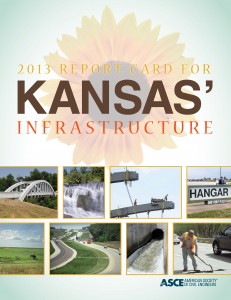 Tom Jacobs, P.E., Report Card Committee Co-Chair for Kansas, accompanied the news by impressing upon elected officials the need to do better. “To our elected officials I only ask this question: is a C- good enough? I certainly hope not. We did not elect you to build a C- state. Our roads, levees, bridges and dams need long-term investment in order to have long-term success.”
“Our state’s future is dependent upon whether we can attract businesses and allow them to thrive” said Steve Randolph, P.E., President of the ASCE St. Louis Section. “A C- means that businesses cannot reliably and effectively move goods in an ever-changing global marketplace. If we are serious about creating jobs and building a strong economy, then we must also be serious about investing in our infrastructure.”
Each state’s grade was the aggregate of various individual sectors, ranging from Aviation and Energy, to Levees and Wastewater. The grades for each state are broken down as follows:
KANSAS
Tom Jacobs, P.E., Report Card Committee Co-Chair for Kansas, accompanied the news by impressing upon elected officials the need to do better. “To our elected officials I only ask this question: is a C- good enough? I certainly hope not. We did not elect you to build a C- state. Our roads, levees, bridges and dams need long-term investment in order to have long-term success.”
“Our state’s future is dependent upon whether we can attract businesses and allow them to thrive” said Steve Randolph, P.E., President of the ASCE St. Louis Section. “A C- means that businesses cannot reliably and effectively move goods in an ever-changing global marketplace. If we are serious about creating jobs and building a strong economy, then we must also be serious about investing in our infrastructure.”
Each state’s grade was the aggregate of various individual sectors, ranging from Aviation and Energy, to Levees and Wastewater. The grades for each state are broken down as follows:
KANSAS
- Aviation earned a C. Twenty-five percent of Kansas’ airports with paved runways need improvement. System-wide, only 36 percent of Kansas airports meet the benchmark for clear approaches to the primary runway.
- Bridges were awarded a D+, in part due to Kansas’s nearly 3,000 structurally deficient bridges. Only five states have more structurally deficient bridges than Kansas.
- Dams earned the lowest grade of a D-. Of the state’s 6,087 dams, 230 are classified as high hazard, meaning failure would likely lead to loss of life and significant property damage.
- Drinking Water earned a C. Presently, there are no dedicated revenue streams to support the necessary funding to support the Kansas’ Water Plan initiatives.
- Energy was awarded a C-. Kansas ranks in the top ten for crude oil production and has one of the richest natural gas fields in the United States.
- Levees earned a C-, in part due to the fact that there are no consistent standards or regulations governing the maintenance and ongoing inspection of levees in the State.
- Railroads earned a C. Kansas has the sixth largest rail system in the United States. Funding sources for the long-term investments have not been identified yet.
- Roads earned the highest grade of a C+. A decrease in federal and state funding levels has a direct impact on the quality of roads in Kansas, from safety to pavement condition.
- Schools earned a C+. There was a huge expansion in the 1950s where the amount of schools in Kansas more than doubled. These building are now 60 years old and many are in need of major repair or replacement.
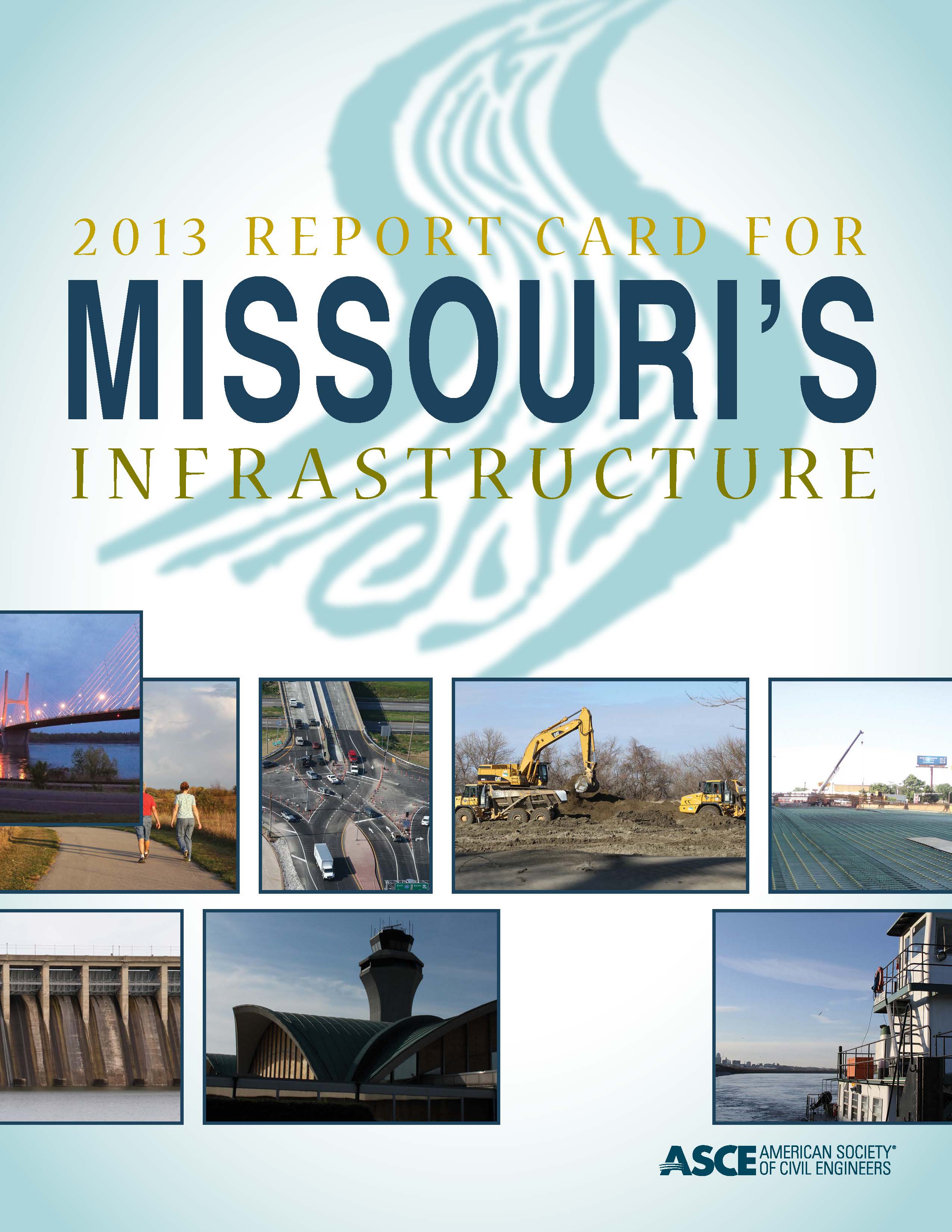 MISSOURI
MISSOURI
- Aviation earned a C grade, in part due to the fact that over the next five years, a shortfall of slightly more than $81 million is anticipated for MO’s aviation sector.
- Bridges was awarded a C-.Missouri has 339 functionally obsolete bridges (12 percent of Missouri’s bridge inventory). Missouri has the 19th lowest percentage in the country.
- Dams received the lowest grade of D-. Missouri has 1,588 high hazard dams (meaning failure would likely lead to loss of life and significant property damage), and 3,511 significant or low hazard dams.
- Drinking Water earned a C-. Even though Missouri has an abundance of water for serving its communities, its aging water treatment and distribution systems are struggling to keep up with current demand.
- Energy earned a D+. Missouri’s shift away from coal and toward more sustainable energy systems, is requiring increased investment in generation facilities, transmission and distribution networks.
- Inland Waterways was awarded a D. Each year the Missouri River carries 8 million tons of cargo, throughout its navigable length. The Mississippi River carries 58 million tons to the mouth of the Missouri River, and 189 million tons to Baton Rouge, Louisiana.
- Levees were awarded a C-. It is estimated that 85 percent of Missouri’s levees are not a part of the National Levee Database.
- Railroads received a C. In order to meet future travel demands, greater funding and much greater support from the State will be necessary.
- Roads earned a C. The last time the state of Missouri passed a piece of transportation funding-related legislation was in 2004. The funding generated by the bill allowed for 2,200 miles of the state’s busiest highways to be smoother and safer, sped up 55 critical highway projects and allowed $1.6 billion in new construction.
- Schools earned a C, in part due to education budget cuts and a lack of long-term funding.
- Wastewater earned a C-. The state of Missouri has a network of established wastewater systems that have been functionally serving citizens for over 50 years in some locations.
Washington State Report Card Released Today!
May 21st, 2013 | By: America's Infrastructure Report Card
Washington’s transportation infrastructure has significant needs according to a new report by the Seattle Section of the American Society of Civil Engineers (ASCE). The new report, titled the 2013 Report Card for Washington’s Infrastructure, awarded Washington State’s infrastructure a C due to a lack of planned funding and inadequate maintenance. “We cannot hope to have an A+ economy, with a C level infrastructure,” said James Chae, P.E., M.ASCE, president of the Seattle Section. “Washingtonians need to realize that our ailing infrastructure hurts our wallets and our livelihoods. In fact, travel delays cost Washington State drivers and businesses more than 32 million hours a year, valued at over $1.1 billion annually.” According to the Report Card, Washington’s roads and transit systems performed the worst of all evaluated sectors, both returning scores of D+. Nine different categories were graded:- Aviation earned a C grade as aging facilities, cumbersome land-use policies, and a lack of available funds have detrimental impacts on Washington’s aviation system.
- Bridges were awarded a C-, in part due to the nearly 400 structurally deficient bridges in Washington State. 36 percent of Washington’s bridges are past their design life of 50 years.
- Dams earned the highest grade in the Report Card: a B. However, close to 40 percent of Washington’s dams are categorized as significant or high hazard dams. A large proportion of dams in Washington are over 50 years old, and development downstream of many dams has significantly increased since the dams were built.
- Drinking Water earned a C-. While only a small percentage of the state’s population is served by smaller water systems serving 25 people or less, they account for 85 percent of the state’s water systems and are only regulated at the county level.
- Rail was awarded a C-, due to the concerning condition of some congested corridors and short line rails. By 2030, $2 billion worth of improvements are needed and 90 percent of these projects are unfunded.
- Roads earned one of the lowest grades in the Report Card: a D+. The system, much of which was built 50 to 60 years ago, is struggling under increasing traffic and financial pressure. Reduced maintenance has caused an 11 percent increase in state highway paving backlog and a 32 percent decrease in county road paving.
- Schools were awarded a mediocre grade of C, in part due to the fact that by 2018, 56 districts are anticipated to be under capacity by about 50,000 students. During the last decade, districts who attempt to raise capital for school facilities locally have faced a 50% failure rate with voters.
- Solid Waste/Hazardous Waste earned a C. Over 16 million tons of waste was generated in Washington by citizens, industry, and manufacturing in 2010.
- Transit earned a D+ grade, in part due to the pace of transit maintenance and expansion not keeping up as transit competes for scarce transportation dollars at the state and federal level.
Pikes Peak Rural Transportation Authority Up For Renewal on November 6th
October 15th, 2012 | By: America's Infrastructure Report Card
On November 6th, our country will face many difficult decisions about its future. However, one issue in Colorado Springs, CO is not difficult whatsoever: the renewal of the Pikes Peak Rural Transportation Authority (PPRTA). Question 5A asks voters in El Paso County, Colorado to approve the extension of the PPRTA, a one percent tax to improve roads and bridges. The initiative is not a tax increase, but rather a continuation of an already successful program. Currently, the PPRTA funds the construction and maintenance of area road projects. In fact, the Colorado Springs Independent argues “the accomplishments of PPRTA I were huge,” and “the projects now are equally vital, taking care of major needs to existing infrastructure, and improving roads and bridges that our governments no longer have the wherewithal to address.” Civil engineers have taken to supporting the PPRTA. ASCE is releasing the 2012 Report Card for Colorado Springs Infrastructure this coming Wednesday. In the report, local civil engineers examine the needs of El Paso County and how and why PPRTA is vital for continued infrastructure improvements. So on November 6th, please remember that transportation infrastructure allows us to go to work in the morning, get our children to school safely, and connect to businesses all over the world.Tags: economics, state report cards, transportation
No Comments »
New Mexico Releases New State Infrastructure Report Card
October 1st, 2012 | By: America's Infrastructure Report Card
On September 21, the New Mexico Section of the American Society of Civil Engineers released the 2012 Report Card for New Mexico’s Infrastructure(Report Card). In its newest report, the New Mexico Section graded the state’s infrastructure a C overall, with aviation, rail, road, and solid waste infrastructure worsening since the last report in 2005. The Report Card urges public officials to increase infrastructure investment and keep pace with New Mexico’s rapid growth. “How we get to work, how we raise our families, and how we can build a more sustainable future all depend on infrastructure,” said ASCE President Andrew W. Herrmann, P.E., SECB. “Given that only one of the 10 areas grades above a ‘C,’ we hope this Report Card will serve as a wakeup call that we must do more. Maintaining and modernizing our infrastructure – our roads, bridges, and water systems –should be a top priority to meet the needs of New Mexican families now and in the future.” The Report Card was picked up by numerous media outlets, including the Santa Fe New Mexican, the Farmington Daily Times, the New Mexico Business Journal, and KOB Eyewitness 4 News. To view the media coverage, please click on the respective link and feel free to share the stories with anyone you know. Only through working together can we hope to improve New Mexico’s infrastructure.New Report Shows Mississippi’s Infrastructure Needs a Different Approach
July 30th, 2012 | By: America's Infrastructure Report Card
Last week, the Mississippi Section Report Card for the state’s infrastructure was featured in a front-page article in the Jackson Courier-Journal and Acey Roberts, P.E., M.ASCE, chair of the Report Card Committee, was interviewed on the Marshall Ramsey show, heard in Jackson on WFMN-FM. Roberts talked about Report Card which gave grades of D for Dams, D, C- for Drinking Water, C for Roads and Bridges, and C for Wastewater, C. Although the grades for Mississippi are either equal to or slightly higher than the nation’s grades, he said current issues must be addressed. “The current path regarding maintenance and funding for our transportation and water systems in Mississippi must be reversed, said Roberts. “We hope that this report will be the first step toward understanding the issues and finding real solutions to bridge the funding gap. Industry experts from public agencies, private firms and non-profit groups led this Report Card effort. To arrive at grades for each area of infrastructure, civil engineering expert volunteers examined the physical condition, capacity and future need, and studied funding sources and trends that impact maintenance and upgrades. The first report of its kind in Mississippi, ASCE’s Mississippi Section released the Report Card at the Mississippi State Capitol Building. To view the 2012 Mississippi Infrastructure Report Card, visit the ASCE Mississippi Section website. View Clarion-Ledger story. Listen to an archive of the Marshall Ramsey radio show from July 26.Tags: civil engineers, economics, energy, infrastructure, infrastructure report card, state report cards, transportation, wastewater, water infrastructure
No Comments »



 */ ?>
*/ ?>





















